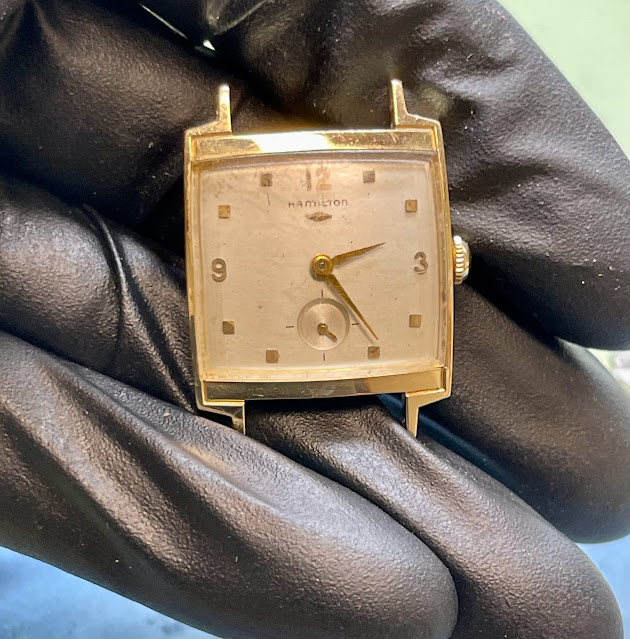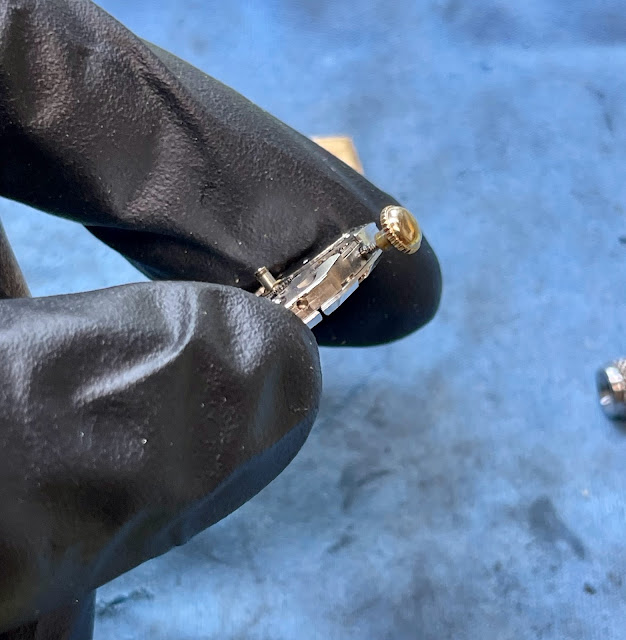It's been a while since I've come across a new model that I haven't seen before. This one is pretty interesting. It's a 1958 Carteret.
One thing that's interesting is the name... most Hamilton models have men's names but there are plenty of exceptions. Carteret would be an unusual name for a man but there are some towns and counties with that name - so maybe it's named after a place. It could also be related to an surname from Normandy, France.
The Gramercy and the Carteret were each introduced in 1958 and produced for three years. Obviously the dials are different but a major difference between the two models is the case material. The Gramercy was cased in 10K yellow gold fill while the Carteret has a solid 14K gold case. That means another major difference between the two models was the price. The Carteret was good $45.50 more than the Gramercy. That may not sound like a lot, but that's equivalent to over $480 in today's dollars. Overall, in today's dollars a Carteret would set you back about $1,430 - that's not too back for a solid gold watch.
My project watch arrived in typical "as found in a drawer" condition. The crystal is a little beat up but the rest of it should clean up nicely.
The case back is engraved with a presentation for 31 years of service... how many companies would reward their employees today for such dedication?
I can tell that this watch has been through someone's hands because they left their fingerprint on the corner of the dial. I try to wear gloves and clean my hands before handling watches and try very hard not to touch the dial. Notice this dial has a two-tone pattern with a strip on the left and right sides. It's very subtle.
Somewhere along the line one of the dial foot screws was lost to eternity. That's one of the reasons I tend to only work on Hamiltons - from time to time you need a replacement screw, or spring, or whatever and you wouldn't want to have to purchase a donor movement just to get a dial foot screw.
The movement looks fairly clean but it will sparkle a lot more once it's been through the spa treatment.
While the parts are in the cleaner I'll prep a new crystal for the bezel. Notice it's the same crystal used on the Gramercy.
Everything is cleaned and ready to be reasssembled.
The final parts are installed and the balance is ticking away with a good motion. Time to see what the timer thinks of it.
A couple of minor tweaks brings the beat rate right in line. It's running like it's brand new.
A new crystal and a nice lizard strap complete the restoration. The dial cleaned up a little better but I can still see the marks in the upper left. Oh well, I'll have a couple of blemishes when I'm 65 too someday.












Nice!
ReplyDeleteCan you point me to a source to explain how to tweak the beat error?
Best regards,
~~Tom
Some of my posts get into that but the answer is "it depends". Some movements have a moveable hairspring stud on the balance cock. Other movements, like this one, require the balance to be removed from the balance cock and you rotate the hairspring collet on the balance staff in order to (hopefully) center the balance to the pallet fork, reducing the beat error.
Delete